What metal panel is best for radius roof systems?
There are many different styles of roofing panels that can be curved for radius applications. So which type of metal roofing system is best for these unique projects?
As you might expect, each panel style has different curving capabilities, strengths, and weaknesses. Given that, let’s work through some of the top criteria so that you can make an informed decision on your next project involving a radius roof.
Roof Radius
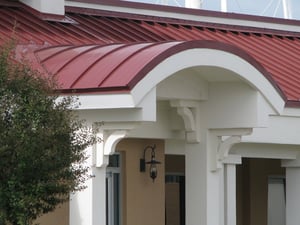 The first consideration when selecting a panel for a radius roof application should be the radius dimension. Some panels work for tighter radius applications based on the panel design, where others simply won’t.
The first consideration when selecting a panel for a radius roof application should be the radius dimension. Some panels work for tighter radius applications based on the panel design, where others simply won’t.
While many different manufacturers offer panels for curved applications, to help demonstrate this point, let’s compare the curved offerings from McElroy Metal shown in the table below.
As you can see, for tight radii in the 3’ neighborhood, the only option we could offer would be our Medallion I, a pan and snap-on batten system.
McElroy Metal Offering |
||
McElroy Trade Name |
Panel Style |
Minimum Radius |
|
Pan and Snap-on Batten
|
Steel 30”
|
|
|
Mechanically Seamed Vertical Leg
|
Steel 12’
Aluminum10’
|
|
|
Mechanically Seamed Vertical Leg
|
Steel 25’
Aluminum 20’
|
|
|
Mechanically Seamed “T” Style Panel
|
Steel & Aluminum 9’
|
|
|
Mechanically Seamed “T” Style Panel
|
Steel 24’
Aluminum 14’
|
|
Continuing with this example, if you’re dealing with a radius roof of 25’ or greater, any of our five-panel options would work. Focusing on the radius dimension first keeps you from selecting a product that simply won’t work for the project at hand.
Performance Required
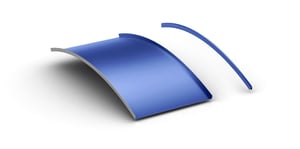 Once you’ve determined the types of panels that will form and properly install to your radius roof, the next consideration should center around performance. Based on both the panel and clip design, some systems offer improved uplift values over others.
Once you’ve determined the types of panels that will form and properly install to your radius roof, the next consideration should center around performance. Based on both the panel and clip design, some systems offer improved uplift values over others.
Again using our McElroy offering as an example, while our Medallion I system can be curved to the tightest radius, it doesn’t offer the more rigorous ASTM E 1592 or FM 4471 uplift testing that our other four systems do.
Consequently, for projects where high wind uplift values are required, a separate pan and batten system, like our Medallion I, would not be the best product selection.
Weathertightness Warranties
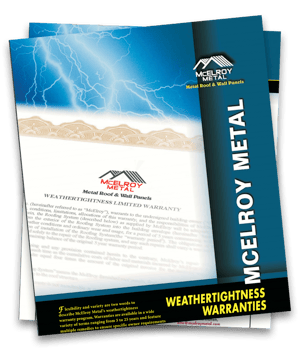 Admittedly the performance criteria just discussed are critically important. So too, is the system’s ability to keep water from penetrating the structure. While some of the available systems are hydrostatic (meaning they are considered watertight in static or non-moving water), other systems are considered hydrokinetic (meaning they can only accommodate moving water) and are referred to as water shedders.
Admittedly the performance criteria just discussed are critically important. So too, is the system’s ability to keep water from penetrating the structure. While some of the available systems are hydrostatic (meaning they are considered watertight in static or non-moving water), other systems are considered hydrokinetic (meaning they can only accommodate moving water) and are referred to as water shedders.
Given this difference, if a weathertightness warranty (WTW) is essential to the owner, hydrokinetic systems will be automatically excluded.
At McElroy Metal, we offer a WTW on four of our five panel systems for radius applications. While our Medallion I style panel can be the most cost-effective and work for the tightest radius applications, it is a hydrokinetic system (can only accommodate “moving” water) and consequently doesn’t offer a WTW warranty. Note the red column added to the chart below.
McElroy Metal Offering |
|||
McElroy Trade Name |
Panel Style |
Minimum Radius |
WTW Available |
|
Pan and Snap-on Batten
|
Steel 30”
|
No
|
|
|
Mechanically Seamed Vertical Leg
|
Steel 12’
Aluminum10’
|
Yes
|
|
|
Mechanically Seamed Vertical Leg
|
Steel 25’
Aluminum 20’
|
Yes
|
|
|
Mechanically Seamed “T” Style Panel
|
Steel & Aluminum 9’
|
Yes
|
|
|
Mechanically Seamed “T” Style Panel
|
Steel 24’
Aluminum 14’
|
Yes
|
|
Contractor Experience
 Once the project radius, performance, and WTW requirements have been considered, the next most crucial consideration involves contractor experience.
Once the project radius, performance, and WTW requirements have been considered, the next most crucial consideration involves contractor experience.
The original family of the curved panel and batten products, like our Medallion I, typically require the contractor to rent and operate machinery to curve the panels and battens themselves.
For contractors experienced with roll forming equipment, this can be a relatively risk-free and straightforward process; however, for those with less experience, as you might expect, things can get challenging very quickly.
The more robust metal panel systems for radius applications (like our other four products) are “typically” also curved on-site; however, for these types of systems the curving process is most often completed by factory personnel who are fully trained and routinely operate the roll forming equipment.
Unfortunately, you can’t assume that all manufacturers approach the curving of their panels like us. Hence, it’s always best to ask “who” completes the curving if this criterion is essential to you.
Bottom line: Operation of the curving equipment is a critical component to both the aesthetics and functionality of a curved roofing project and should always be given serious consideration.
Project Size & Budget
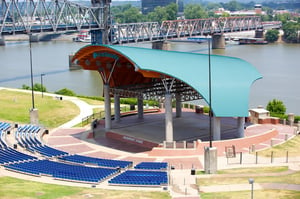 Because the options are limited, project size and budget, while lower on the list, are also important considerations in panel selection for radius applications.
Because the options are limited, project size and budget, while lower on the list, are also important considerations in panel selection for radius applications.
Let’s look at the curving cost first. While having factory personnel complete the curving operation can reduce risk, it also carries an additional charge for machinery and personnel to move around the country to various job sites.
On large projects, thanks to economies of scale, the difference tends to be minimal and usually easy to justify given the numerous advantages. But for smaller projects involving just a few curved panels for canopies, the cost difference can be substantial and cost-prohibitive.
There are also differences in the actual material cost associated with various systems. The least expensive products tend to be pan and batten systems (like our Medallion I), then moving up to integrated panel leg systems (like our Maxima family) and the T style systems (like our 138T/238T) tend to present the highest costs. Note: the red column on the right added to the chart below illustrating a material cost comparison.
McElroy Metal Offering |
||||
McElroy Trade Name |
Panel Style |
Minimum Radius |
WTW Available |
Material Cost |
|
Pan and Snap-on Batten
|
Steel 30”
|
No
|
Low
|
|
|
Mechanically Seamed Vertical Leg
|
Steel 12’
Aluminum10’
|
Yes
|
Medium
|
|
|
Mechanically Seamed Vertical Leg
|
Steel 25’
Aluminum 20’
|
Yes
|
Medium
|
|
|
Mechanically Seamed “T” Style Panel
|
Steel & Aluminum 9’
|
Yes
|
High
|
|
|
Mechanically Seamed “T” Style Panel
|
Steel 24’
Aluminum 14’
|
Yes
|
High
|
|
Panel Style
No discussion of radius roof systems would be complete without touching on the different panel styles available.
Aesthetically, there is much to consider. For example, some of the systems offer a very pronounced batten width, like our 138T/238T panels, which can create a tremendous visual appeal; however, others prefer the narrower look of the integrated panel leg systems like our Maxima.
As you might expect, aesthetic decisions boil down to personal opinion. There is no right or wrong answer, but they are certainly part of the equation.
Contractor ease should be another consideration in system selection for radius roof applications. The main product families in this space are integrated panel leg panel systems, like our Maxima, and a separate panel and cap system like our 138T/238T/Medallion product family.
By nature, integrated panel leg systems require contractors to roll a panel into place and hook (or engage it) with the preceding panel. In comparison, T-style panels allow contractors to push two panels together without rolling them into place. While that may not seem like a big difference, for crews working on steep pitches or projects over one story tall, the difference in both comfort and install quality can be staggering. Consequently, most contractors prefer to install T-style panels.
In some cases, manufacturers can also produce panel and curve panels right on to the roofing surface. When this is possible, contractors save labor because they don't hoist individual crates of panels to the roof surface. Further, producing panels on the roof means that crews aren't required to spend time to unpack panels, dismantle crates and hoist the crating material back down to the ground.
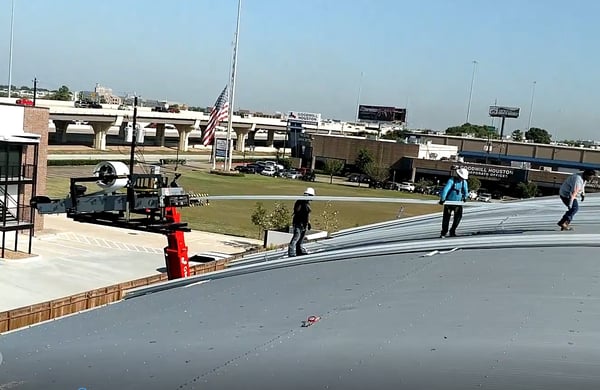
Consequently, many contractors prefer rooftop production when possible. At McElroy Metal, we can run curved 238T panels right onto the roof when the radius exceeds 100 feet.
Panel replaceability is another consideration in panel selection for radius applications. It can be difficult (if not impossible) to repair or replace one panel in the field of the roof with integrated panel leg systems like our Maxima.
Consequently, building owners can find themselves having to remove perfectly good roof panels to access a damaged area that needs to be repaired. However, like our 138T/238T, T-style systems allow for easy repair or replacement of single panels without tearing off the entire roof back to the affected area. Individual panel replaceability is a big differentiator and should be considered.
Like our 138T/328T, T style panels are the most expensive of our radius panel offering; however, given the contractor’s ease of installation and individual panel replaceability, they are also overwhelmingly selected.
Summary
There are many different considerations when selecting products for any project, and radius roofing projects are no different. Considering the radius, performance, and warranties required all represent essential factors. But contractor experience, project size, and panel style also shouldn’t be overlooked.
Still not sure what type of system is best for your radius roof system? Contact us; we’re here to help!
About McElroy Metal
Since 1963, McElroy Metal has served the construction industry with quality products and excellent customer service. The employee-owned components manufacturer is headquartered in Bossier City, La., and has 14 manufacturing facilities across the United States. Quality, service and performance have been the cornerstone of McElroy Metal’s business philosophy and have contributed to the success of the company through the years. As a preferred service provider, these values will continue to be at the forefront of McElroy Metal’s model along with a strong focus on the customer.



.png?width=767&name=What%20to%20Expect%20When%20You%20Order%20From%20McElroy%20Metal%20(1).png)


.png?width=440&height=293&name=How%20to%20Install%20Metal%20Roofing%20Over%20Existing%20Metal%20Roofs%20(1).png)


Comments on this article:
Scroll down to the bottom to submit a comment and join the conversation. Need help or have a question? Please contact us. Looking for a distributor or contractor? Please click here to get started.